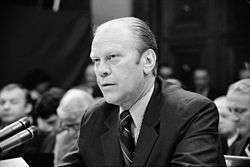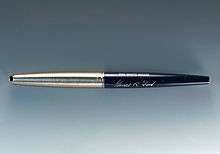Pardon of Richard Nixon
| ||
|---|---|---|
|
Vice President of the United States
Post-vice presidency
President of the United States
First term
Second term
Post-presidency
 |
||

A presidential pardon of Richard Nixon (Proclamation 4311 ![]()
Pardon
Following the release of the smoking gun tape on August 5, 1974, Nixon's position had become untenable. In his autobiography A Time to Heal, Ford wrote about a meeting he had with White House Chief of Staff Alexander Haig before Nixon's resignation. Haig was explaining what he and Nixon's staff thought were Nixon's only options. He could try to ride out the impeachment and fight against conviction in the Senate all the way, or he could resign. His options for resigning were to delay his resignation until further along in the impeachment process, to try and settle for a censure vote in Congress, or to pardon himself and then resign. Haig told Ford that some of Nixon's staff suggested that Nixon could agree to resign in return for an agreement that Ford would pardon him.
Haig emphasized that these weren't his suggestions. He didn't identify the staff members and he made it very clear that he wasn't recommending any one option over another. What he wanted to know was whether or not my overall assessment of the situation agreed with his.[emphasis in original]... Next he asked if I had any suggestions as to courses of actions for the President. I didn't think it would be proper for me to make any recommendations at all, and I told him so.
— Gerald Ford, A Time to Heal[4]
Ford later decided to pardon Nixon for other reasons, primarily the friendship he and Nixon shared.[5]

Following his resignation on August 9, 1974, the Nixons flew to their home La Casa Pacifica in San Clemente, California.[6] According to his biographer, Jonathan Aitken, after his resignation, "Nixon was a soul in torment".[7] Congress had funded Nixon's transition costs, including some salary expenses, though reducing the appropriation from $850,000 to $200,000. With some of his staff still with him, Nixon was at his desk by 7 a.m.—with little to do.[7] His former press secretary, Ron Ziegler, sat with him alone for hours each day.[8]
Nixon's resignation had not put an end to the desire among many to see him punished. The Ford White House considered a pardon of Nixon, though it would be unpopular in the country. Nixon, contacted by Ford emissaries, was initially reluctant to accept the pardon, but then agreed to do so. Ford, however, insisted on a statement of contrition; Nixon felt he had not committed any crimes and should not have to issue such a document. Ford eventually agreed, and on September 8, 1974, he granted Nixon a "full, free, and absolute pardon", which ended any possibility of an indictment. Nixon then released a statement:
I was wrong in not acting more decisively and more forthrightly in dealing with Watergate, particularly when it reached the stage of judicial proceedings and grew from a political scandal into a national tragedy. No words can describe the depth of my regret and pain at the anguish my mistakes over Watergate have caused the nation and the presidency, a nation I so deeply love, and an institution I so greatly respect.[9][10]
Public response
The Nixon pardon was controversial. Critics derided the move, and claimed a "corrupt bargain" had been struck between the men: that Ford's pardon was granted in exchange for Nixon's resignation, elevating Ford to the presidency. Ford's first press secretary and close friend Jerald terHorst resigned his post in protest after the pardon.
The Nixon pardon was a pivotal moment in the Ford presidency. Historians believe the controversy was one of the major reasons Ford lost the election in 1976, an observation with which Ford agreed.[5] In an editorial at the time, The New York Times stated that the Nixon pardon was a "profoundly unwise, divisive, and unjust act" that in a stroke had destroyed the new president's "credibility as a man of judgment, candor, and competence". Allegations of a secret deal made with Ford, promising a pardon in return for Nixon's resignation, led Ford to testify before the House Judiciary Committee on October 17, 1974.[11][12] He was the first sitting President to testify before the House of Representatives since Abraham Lincoln.[13][14] Ford's approval rating dropped from 71% to 50% following the pardon.[15]
Aftermath
With President Nixon's resignation, Congress dropped its impeachment proceedings against him. Criminal prosecution was still a possibility both on the federal and state level.[16]
In October 1974, Nixon fell ill with phlebitis. Told by his doctors that he could either be operated on or die, a reluctant Nixon chose surgery, and President Ford visited him in the hospital. Nixon was under subpoena for the trial of three of his former aides—John Dean, H. R. Haldeman, and John Ehrlichman—and The Washington Post, disbelieving his illness, printed a cartoon showing Nixon with a cast on the "wrong foot". Judge John Sirica excused Nixon's presence despite the defendants' objections.[17] Congress instructed Ford to retain Nixon's presidential papers—beginning a three-decade legal battle over the documents that was eventually won by the former president and his estate.[18] Nixon was in the hospital when the 1974 midterm elections were held, and Watergate and the pardon were contributing factors to the Republican loss of 43 seats in the House and three in the Senate.[19]

After Ford left the White House in 1977, he privately justified his pardon of Nixon by carrying in his wallet a portion of the text of Burdick v. United States, a 1915 U.S. Supreme Court decision that suggested that a pardon carried an imputation of guilt and that acceptance carried a confession of guilt.[20] In 2001, the John F. Kennedy Library Foundation awarded the John F. Kennedy Profile in Courage Award to Ford for his pardon of Nixon.[21] In presenting the award to Ford, Senator Ted Kennedy said that he had initially been opposed to the pardon of Nixon, but later stated that history had proven Ford to have made the correct decision.[22]
See also
References
- ↑ Ford, Gerald (September 8, 1974). "President Gerald R. Ford's Proclamation 4311, Granting a Pardon to Richard Nixon". Gerald R. Ford Presidential Library & Museum. Retrieved December 22, 2016.
- ↑ "Ford Pardons Nixon – Events of 1974 – Year in Review". UPI.com. Retrieved November 4, 2011.
- ↑ Ford, Gerald (September 8, 1974). "Gerald R. Ford Pardoning Richard Nixon". Great Speeches Collection. The History Place. Retrieved December 30, 2006.
- ↑ Ford (1979), 4.
- 1 2 Shane, Scott (December 29, 2006). "For Ford, Pardon Decision Was Always Clear-Cut". The New York Times. p. A1. Retrieved September 8, 2009.
- ↑ Nixon Library, Post Presidency.
- 1 2 Aitken, p. 529.
- ↑ Aitken, pp. 529–30.
- ↑ Aitken, p. 532.
- ↑ Black, p. 990.
- ↑ Gettlin, Robert; Colodny, Len (1991). Silent Coup: The Removal of a President. New York: St. Martin's Press. p. 420. ISBN 0-312-05156-5. OCLC 22493143.
- ↑ Ford, Gerald R. (1979). A Time to Heal: The Autobiography of Gerald R. Ford. San Francisco: Harper & Row. pp. 196–99. ISBN 0-06-011297-2.
- ↑ "Ford Testimony on Nixon Pardon – C-SPAN Video Library". C-spanvideo.org. October 17, 1974. Retrieved December 30, 2012.
- ↑ "Sitting presidents and vice presidents who have testified before congressional committees" (PDF). Senate.gov. 2004. Retrieved November 22, 2015.
- ↑ Carroll, Joseph (May 21, 2001). "Americans Grew to Accept Nixon's Pardon". gallup.com. Retrieved May 17, 2017.
- ↑ "The Legal Aftermath Citizen Nixon and the Law". Time. August 19, 1974. Retrieved July 24, 2011.
- ↑ Aitken, pp. 533–34.
- ↑ Black, pp. 994, 999.
- ↑ Black, p. 998.
- ↑ Shadow, by Bob Woodward, chapter on Gerald Ford; Woodward interviewed Ford on this matter, about 20 years after Ford left the presidency
- ↑ "Award Announcement". JFK Library Foundation. May 1, 2001. Retrieved March 31, 2007.
- ↑ "Sen. Ted Kennedy crossed political paths with Grand Rapids' most prominent Republican, President Gerald R. Ford", The Grand Rapids Press, August 26, 2009. Retrieved January 5, 2010.
Further reading
- Aitken, Jonathan (1996). Nixon: A Life. Washington, D.C.: Regnery Publishing. ISBN 978-0-89526-720-7.
- Black, Conrad (2007). Richard M. Nixon: A Life in Full. New York: PublicAffairs Books. ISBN 978-1-58648-519-1.
